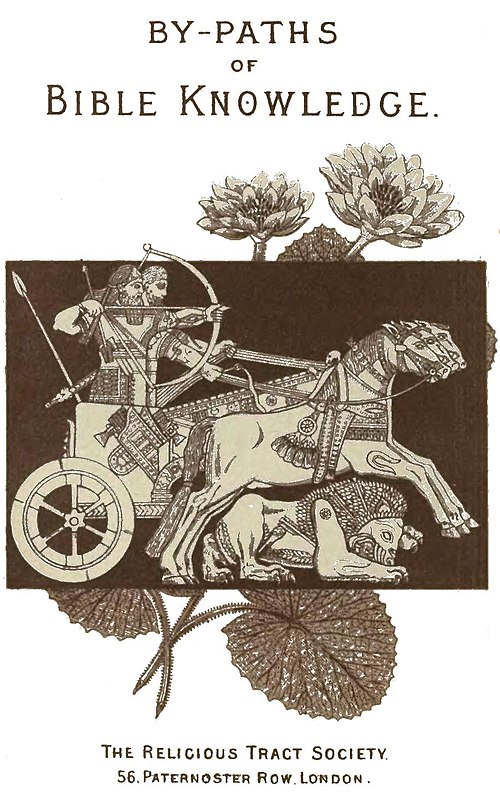The Hittites
By-Paths of Bible Knowledge.
XII.
THE HITTITES
THE STORY OF A FORGOTTEN EMPIRE.
BY
A. H. SAYCE, LL. D.
DEPUTY PROFESSOR OF PHILOLOGY, OXFORD;
AUTHOR OF 'FRESH LIGHT FROM THE ANCIENT MONUMENTS,'
'ASSYRIA, ITS PRINCES, PRIESTS AND PEOPLE,' ETC., ETC.
Second Edition
THE RELIGIOUS TRACT SOCIETY,
56 Paternoster Row, 65 St. Paul's Churchyard, and 164 Piccadilly.
1890.
Oxford
HORACE HART, PRINTER TO THE UNIVERSITY
PREFACE.
The discovery of the important place once occupied by the Hittites has been termed 'the romance of ancient history.' Nothing can be more interesting than the resurrection of a forgotten people, more especially when that people is so intimately connected with Old Testament story, and with the fortunes of the Chosen Race. How the resurrection has been accomplished, by putting together the fragmentary evidence of Egyptian and Assyrian inscriptions, of strange-looking monuments in Asia Minor, and of still undeciphered hieroglyphics, will be described in the following pages. It is marvellous to think that only ten years ago 'the romance' could not have been written, and that the part played by the Hittite nations in the history of the world was still unsuspected. Yet now we have become, as it were, familiar with the friends of Abraham and the race to which Uriah belonged.
Already a large and increasing literature has been devoted to them. The foundation stone, which was laid by my paper 'On the Monuments of the Hittites' in 1880, has been crowned with a stately edifice in Dr. Wright's Empire of the Hittites, of which the second edition appeared in 1886, and in the fourth volume of the magnificent work of Prof. Perrot and M. Chipiez, L'Histoire de l'Art dans l'Antiquité, published at Paris a year ago. Profusely illustrated, the latter work sets before us a life-like picture of Hittite architecture and art.
It cannot be long before the inscriptions left to us by the Hittites, in their peculiar form of hieroglyphic writing, are also made to reveal their secrets. All that is required are more materials upon which to work, and we shall then know which, if any, of the attempts hitherto made to explain them has hit the truth. Major Conder's system of decipherment has not yet obtained the adhesion of other scholars; neither has the rival system of Mr. Ball, ingenious and learned as it is. But if we may judge from the successes of the last few years, it cannot be long before we know as much about the Hittite language and writing as we now know about Hittite art and civilisation. To quote the words of Dr. Wright: 'We must labour to unloose the dumb tongue of these inscriptions, and to unlock their mysteries, not with the view of finding something sensational in them, or for the purpose of advancing some theory, but for the love of knowing what they really contain; and I doubt not that, proceeding in the right method of investigation, we shall reach results satisfactory to the Oriental scholar, and confirmatory of Divine truth.'
Queen's College, Oxford.
October 1888.
TABLE OF CONTENTS.
| CHAP. | PAGE | |
| I. | The Hittites of the Bible | 11 |
| II. | The Hittites on the Monuments of Egypt and Assyria | 19 |
| III. | The Hittite Monuments | 54 |
| IV. | The Hittite Empire | 73 |
| V. | The Hittite Cities and Race | 97 |
| VI. | Hittite Religion and Art | 104 |
| VII. | The Inscriptions | 122 |
| VIII. | Hittite Trade and Industry | 136 |
LIST OF ILLUSTRATIONS.
| PAGE | |
| Slabs with Hittite Sculpture at Keller near Aintab | Frontispiece |
| Map illustrating the extent of the Hittite Empire | 10 |
| A Slab found at Merash | 54 |
| Slabs with Hittite Sculptures found at Keller near Aintab | 63 |
| The Pseudo-Sesostris carved on the rock in the Pass of Karabel | 67 |
| Monument of a Hittite King found at Carchemish | 72 |
| The Double-headed Eagle of Eyuk | 84 |
| Sculptures at Boghaz Keui | 88 |
| Sculptures at Boghaz Keui | 91 |
| An Inscription found at Carchemish (now destroyed) | 122 |
| The Bilingual Boss of Tarkondemos | 127 |
| The Lion of Merash | 131 |

MAP ILLUSTRATING THE EXTENT OF THE HITTITE EMPIRE.
(Copied by permission from 'The Empire of the Hittites.)
![]()
This work is in the public domain in the United States because it was published before January 1, 1930.
The longest-living author of this work died in 1933, so this work is in the public domain in countries and areas where the copyright term is the author's life plus 91 years or less. This work may be in the public domain in countries and areas with longer native copyright terms that apply the rule of the shorter term to foreign works.
![]()
Public domainPublic domainfalsefalse



